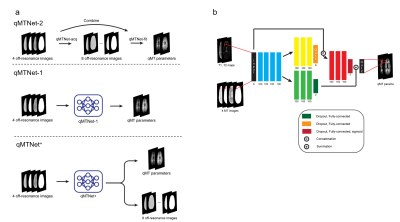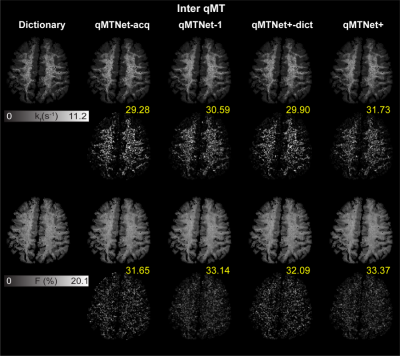Huan Minh Luu1, Dong-Hyun Kim1, Seung-Hong Choi2, and Sung-Hong Park1
1Magnetic Resonance Imaging Laboratory, Department of Bio and Brain Engineering, Korea Advanced Institute of Science and Technology, Daejeon, Korea, Republic of, 2Department of Radiology, Seoul National University Hospital, Seoul, Korea, Republic of
1Magnetic Resonance Imaging Laboratory, Department of Bio and Brain Engineering, Korea Advanced Institute of Science and Technology, Daejeon, Korea, Republic of, 2Department of Radiology, Seoul National University Hospital, Seoul, Korea, Republic of
In this study, we propose qMTNet+, an improved version of qMTNet that accomplishes acceleration for data acquisition and fitting , as well as generation of missing data with a single residual network. Results showed that qMTNet+ improves the quality of generated MT images and qMT parameters.

Figure 1: a) Overview of qMTNet-2,
qMTNet-1 and qMTNet+
approach:
qMTNet-2 comprises of 2 separate sub-networks. qMTNet-1 is a single
integrated network to directly predict qMT parameters from undersampled MT
images. qMTNet+ consists of a single network that can
produce both values of interest. b) Structure of qMTNet+. Unless stated in the caption, the layer includes 100 hidden neurons
with rectified linear unit (ReLU) activation and batch normalization.
Different color signifies different computation path in the network.

Figure 3: Qualitative comparison
between qMTNet+ and qMTNet
output against dictionary fitted qMT parameters on inter-slice MT data.
Dictionary
specifies qMT
parameters obtained from dictionary fitting of acquired MT data and is
considered as the label. The numbers
at the bottom of the images are the peak signal-to-noise ratio. The top two
rows show result for kf and the bottom two rows show result for
F. The first row shows qMT
parameters from the different fitting methods and the second row shows the 5
times magnified absolute differences. Details of the networks are explained in text.
